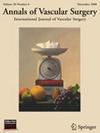Ultrasound-Guided Percutaneous Electrocoagulation of Pathological Perforating Veins in the Treatment of Advanced Chronic Venous Insufficiency of the Lower Extremities: A Retrospective Cohort Study
IF 1.6
4区 医学
Q3 PERIPHERAL VASCULAR DISEASE
引用次数: 0
Abstract
Background
To assess the efficacy and safety of ultrasound-guided electrocoagulation for pathological perforating veins in advanced lower extremity chronic venous insufficiency.
Methods
This study enrolled 455 patients (497 affected limbs) with venous insufficiency. Pathological perforating veins (diameter ≥3.5 mm, reflux duration >500 ms) underwent ultrasound-guided percutaneous trocar-assisted electrocoagulation, while the main trunk of great saphenous vein was treated with endovenous radiofrequency ablation under tumescent anesthesia or local anesthesia. Comparative evaluation of preoperative and postoperative parameters, including Venous Clinical Severity Score (VCSS), ulcer healing status, cutaneous induration, inflammatory markers, pain intensity, and compliance with therapeutic compression therapy, was performed to validate the safety and efficacy of the surgical procedure.
Results
The VCSS of patients at 3, 12, and 24 months postoperatively were (10.30 ± 4.57) points, (4.52 ± 2.00) points and (1.38 ± 1.31) points, respectively, showing a continuous decline compared to the preoperative score of (16.09 ± 6.63) points, with statistically significant differences (P < 0.001). In addition, statistically significant differences were observed in the comparisons between the VCSS at 3 months and 12, 3, and 24 months as well as 12 and 24 months postoperatively (P < 0.001). All patients with lower limb ulcers achieved complete ulcer healing. Four patients experienced ankle pain while walking, which resolved within 2 weeks. No cases of deep vein thrombosis, hematoma, saphenous nerve injury, arterial ischemia, or infection were observed.
Conclusion
Through a retrospective cohort analysis incorporating duplex ultrasonography and standardized clinical outcome metrics, significant improvements in hemodynamic parameters and ulcer healing rates were observed. Ultrasound-guided cannular electro- coagulation of pathological perforating veins demonstrates encouraging safety and efficacy profiles in the management of severe chronic lower extremity venous insufficiency.
超声引导下经皮病理穿静脉电凝治疗晚期下肢慢性静脉功能不全:一项回顾性队列研究。
目的:评价超声引导下电凝治疗晚期下肢慢性静脉功能不全病理性穿静脉的疗效和安全性。方法:本研究纳入455例静脉功能不全患者(497例患肢)。病理穿静脉(直径≥3.5 mm,反流时间> 500ms)行超声引导下经皮套管针辅助电凝,大隐静脉主干(GSV)行肿胀麻醉或局麻下静脉内射频消融(RFA)治疗。对比评估术前和术后参数,包括静脉临床严重程度评分(VCSS)、溃疡愈合状况、皮肤硬化、炎症标志物、疼痛强度和治疗性压迫治疗的依从性,以验证手术的安全性和有效性。结果:患者术后3、12、24个月VCSS评分分别为(10.30±4.57)分、(4.52±2.00)分、(1.38±1.31)分,较术前(16.09±6.63)分持续下降,差异有统计学意义(p)。通过回顾性队列分析,结合双超声检查和标准化的临床结果指标,观察到血流动力学参数和溃疡愈合率的显着改善。超声引导的病理穿孔静脉导管电极凝固在治疗严重慢性下肢静脉功能不全中显示出令人鼓舞的安全性和有效性。
本文章由计算机程序翻译,如有差异,请以英文原文为准。
求助全文
约1分钟内获得全文
求助全文
来源期刊
CiteScore
3.00
自引率
13.30%
发文量
603
审稿时长
50 days
期刊介绍:
Annals of Vascular Surgery, published eight times a year, invites original manuscripts reporting clinical and experimental work in vascular surgery for peer review. Articles may be submitted for the following sections of the journal:
Clinical Research (reports of clinical series, new drug or medical device trials)
Basic Science Research (new investigations, experimental work)
Case Reports (reports on a limited series of patients)
General Reviews (scholarly review of the existing literature on a relevant topic)
Developments in Endovascular and Endoscopic Surgery
Selected Techniques (technical maneuvers)
Historical Notes (interesting vignettes from the early days of vascular surgery)
Editorials/Correspondence

 求助内容:
求助内容: 应助结果提醒方式:
应助结果提醒方式:


